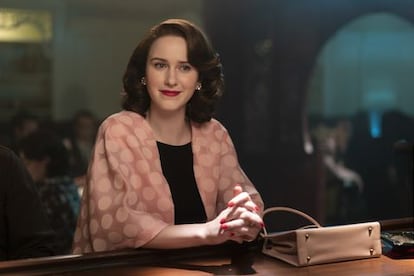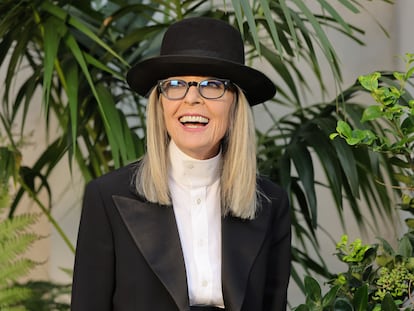How ‘The Marvelous Mrs. Maisel,’ an oddball of contemporary television, became a classic
The fifth and final season of Amy Sherman-Palladino’s show is a masterpiece, a vaudeville of narrative possibilities that has always been a love letter to the friendship between two women


Amy Sherman-Palladino should have a star in her honor somewhere, one that shines with as much intensity as she does. The creator invents an exuberant new narrative genre with everything she makes. The final season of The Marvelous Mrs. Maisel (Amazon Prime Video) is the latest — and most perfect — example. Midge Maisel’s goodbye is a reinvention of the medium and an ode to all that has turned Sherman-Palladino into an avant-garde outsider of 21st century television.
It wasn’t easy to finish off the story of the stand-up comedian. But with the character’s frustrated wedding to Philip Roth, among other crossovers with the real world, the Gilmore Girls creator raised the bar so that this fifth season could function perfectly well as an autonomous work. Everything in it contracts and expands in a game between the present — the series’ timeline — and the future, turning the character’s story into its own closed parallel universe.
When it all begins, we find ourselves again in the sixties. Midge Maisel (the inimitable Rachel Brosnahan) has just accepted a job as a screenwriter on the hottest television show of the moment, The Gordon Ford Show. Her male colleagues alternately ignore and mock her. Meanwhile, Susie Myerson (Alex Borstein, in better shape than ever) has begun to have problems with her mafia business partners, which will complicate their lives in this timeline, juxtaposed with a future in which Midge Maisel is an aging star.
A female Don Quixote and Sancho Panza
This season sublimates the theatrical formula that turned the show into a baroque rare bird. It finally shows all the series’ cards, among them the only one that has mattered since the beginning: the friendship between two women — a sort of female Don Quixote and Sancho Panza — who have made each other into who they are, never letting go, staying on their toes at every moment.
The sixth episode — written by Daniel Palladino, the creator’s husband and right hand since Gilmore Girls — is a triumph. It should go down in the annals of television history as a classic of multiple narration styles: the third person, the unreliable narrator, the layers of the past, the future present, television within television. It condenses the series’ motor into just a few moments. The writers go for broke in presenting the conflict — Midge and Susie fought at some point and haven’t spoken in years — and then resolving it with a redeeming twist, in the form of a masterful phrase.
One night in the mythical Gaslight, Susie Myerson, the future famous representative of artists of all kinds, encountered a nervous wreck — a housewife escaping from her home, her cheating husband and a life that had stopped making sens e— and turned it into a career and a life. She allowed Mrs. Maisel to believe that what she was doing made sense, and she prevented her from ever stopping believing it. In this goodbye to The Marvelous Mrs. Maisel, there is something redeeming about the idea of creation itself: it has to do with the need not to shine, but to believe that you should.
Sign up for our weekly newsletter to get more English-language news coverage from EL PAÍS USA Edition
Tu suscripción se está usando en otro dispositivo
¿Quieres añadir otro usuario a tu suscripción?
Si continúas leyendo en este dispositivo, no se podrá leer en el otro.
FlechaTu suscripción se está usando en otro dispositivo y solo puedes acceder a EL PAÍS desde un dispositivo a la vez.
Si quieres compartir tu cuenta, cambia tu suscripción a la modalidad Premium, así podrás añadir otro usuario. Cada uno accederá con su propia cuenta de email, lo que os permitirá personalizar vuestra experiencia en EL PAÍS.
¿Tienes una suscripción de empresa? Accede aquí para contratar más cuentas.
En el caso de no saber quién está usando tu cuenta, te recomendamos cambiar tu contraseña aquí.
Si decides continuar compartiendo tu cuenta, este mensaje se mostrará en tu dispositivo y en el de la otra persona que está usando tu cuenta de forma indefinida, afectando a tu experiencia de lectura. Puedes consultar aquí los términos y condiciones de la suscripción digital.
More information
Archived In
Últimas noticias
Maduro pleads not guilty before the federal court in New York: ‘I am still the president of Venezuela’
A new test can detect Alzheimer’s from a finger prick
UN team enters Sudanese city of El Fasher after paramilitary massacre: ‘It’s like a ghost town’
A recipe for resistance: Indigenous peoples politicize their struggles from the kitchen
Most viewed
- Gilles Lipovetsky: ‘If you want to live better and fall in love, take Prozac, don’t look to philosophy’
- Alain Aspect, Nobel laureate in physics: ‘Einstein was so smart that he would have had to recognize quantum entanglement’
- Alvin Hellerstein, a 92-year-old judge appointed by Bill Clinton, to preside over Maduro’s trial in New York
- Why oil has been at the center of Venezuela-US conflicts for decades
- Maduro’s downfall puts China’s relationship with Venezuela to the test










































